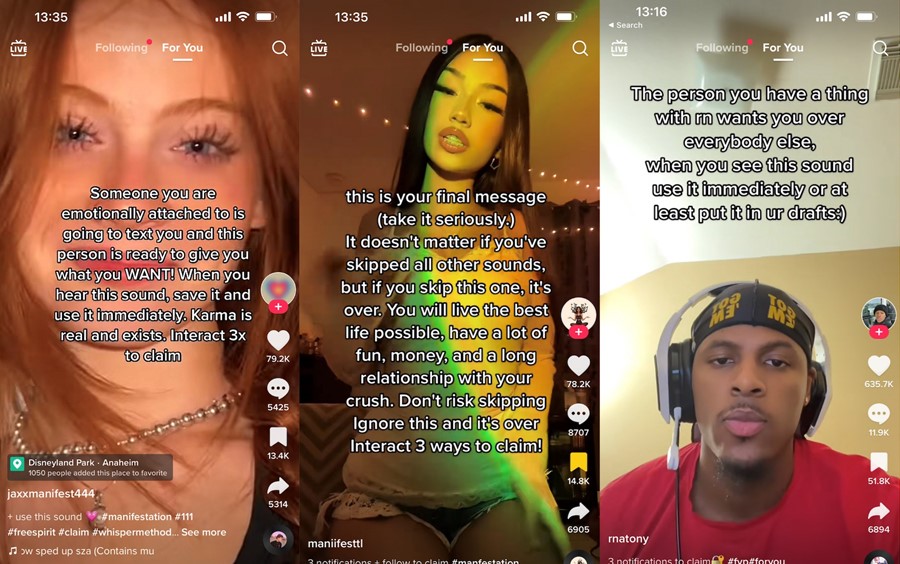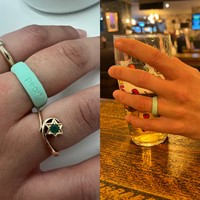Chain letters have been around for decades, but the format has found a new home among TikTok’s spiritual user-base
“If you skip this sound, you have 15 MINUTES before everything starts to go downhill.”
The message appears on my screen while I’m scrolling through TikTok sometime around midnight. Struck by a sudden sense of paranoia, I do as I’m told: use the audio, and save it onto my drafts as the caption instructs. Once I flick through, I realise that my TikTok ‘For You Page’ is suddenly inundated with similar videos promising windfalls of abundance if I “use this sound”, “interact four times to claim”, or share with friends. I’m told that if I choose to ignore and scroll past them, I’m opening myself up to the threat of innumberable impending disasters.
Among all the make-up tutorials and dance routines, there are hundreds of thousands of these videos proliferating on the platform, all powered by TikTok’s powerful algorithm. And it’s nothing new, either: they’re all based on an age-old meme format known as the chain message.
There are thousands of variations of chain messages, typically found in the corners of TikTok where spiritual content runs rampant. Each letter follows a simple formula: they compel users to interact, share and “use this sound” to supposedly call in the life of their dreams or else risk immense misfortune. Some tout the potential to manifest a higher salary or get straight As in school if the viewer simply likes, comments, shares and uses the audio featured in the video. Other clips following this format promise reunion with an ex or a text message from an old situationship, while others threaten the viewer with the worst year of their life if they dare to skip past. They generally tempt viewers with the promise of money (for example, £8,000,000) or threaten them with 30 days of bad luck if they choose not to engage.
Chain letters have their roots in ancient folklore, and are tied to a range of old cultural superstitions and hoaxes. Historically, in both pre- and post-internet times, chain letters have touched on topics relating to luck, protection, religion, charity, humour and scam-like money-generating initiatives. And while many older examples have been lost to the tides of time, folklorist, archivist and mathematician Daniel VanArsdale’s digital archive “Chain Letter Evolution” chronicles over 900 chain letters, stretching all the way back to 55 AD. They’re cultural ephemera, and their pertinence in the minds of recipients is illustrated simply by how much the chain ends up being shared.
@user006382070008 4x + follow to claim 🍀 love you 🤍 #claim #trending #manifest #blowthisup #fyp #viral ♬ 我做了一个很长的梦(剪辑版) - 山崎泽野
According to VanArsdale, spirituality has been the root of some of the earliest chain letters we’ve seen, with one fraudulent parchment even claiming to be authored by Jesus. Although these early examples don’t implore respondents to copy and send a certain number of times as modern chain letters do, they play off local superstitions and paranoia (“pick up this rock and you will be blessed”). They also set the precedent for a later explosion of chain letter schemes in the late 19th and 20th centuries. One example from the 1900s is an early pyramid scheme: the 1935 Send-a-Dime chain letter that started in Denver, Colorado, and urged recipients to “add your name to the bottom of the list” and “send a dime to the name at the top” to potentially win $1,562.50.
But its contemporary iteration, the chain email, can be traced back to the early 90s, with countless ‘Fwd: Fwd: Fwd:’ iterations landing in users’ newly-created Hotmail inboxes. Arguably the precursor to social media, early web chain letters were a way to streamline and share information en masse across a wide range of communities; its distinct format and the threatening consequences for ignoring such messages compelled the recipient to pass on the copy and sustain its longevity.
‘The chain works for a short time and then collapses. In this sense they are a pyramid scheme’ – Susan Blackmore
It could be argued that chain letters are among the earliest examples of a meme, if understood as something that is shared, remixed, adopted and augmented from one participant to another. They compel participants to pass them on by eliciting an emotional response. “What makes for successful memes is anything that will first get your attention and second, get you to pass it on,” explains Susan Blackmore, author of the 1999 book The Meme Machine.
“Meme doesn’t just mean ‘thing on the internet’, or even ‘thing on the internet that gets passed around’,” adds Ryan Milner, associate professor of communications at the College of Charleston in South Carolina and co-author of the 2021 book You Are Here. “Meme in its original sense is any bit of culture that is shared amongst people who adapt it as they share it.”
@smokelifee 3 notifications to unclaim subscribe to my YouTube channel:Soulking To unclaim
♬ Sticks & Stones. - Blank.
But the chain letters of yesteryear and the chain messages proliferating on TikTok are distinctly different. The older versions, as Blackmore stresses, “were not altered when passed on, as so many memes are. They work like religions, by threats and promises: like ‘pass this on to ten friends and you will get good luck’ or ‘if you don’t pass this on you will get bad luck’. The threats are empty, so are the promises. The chain works for a short time and then collapses. In this sense, they are a pyramid scheme.”
@you_manifest Interact 3x to claim 🥰✨️ #manifestation #glowup #clearskin #lawofattraction #beautiful #fyp #viral #claim ♬ original sound - moon🌙
As social media has matured, however, the chain letter has mutated and become ubiquitous – pushed by the algorithm and the potential to generate revenue through monetised views and streams. “If there ever was a platform to bring back chain messages, it’s TikTok. No matter what viewers are doing with them, they’re engaging, and that brings attention to the content creators and that keep users on the platform. Everybody wins,” explains Milner. “[These memes] are a really interesting example of something that is an age-old trend at this point, a very kind of stalwart recurring trend of our contemporary age, but twisted just a little bit to hit the specifics of the platform.”
What makes chain letters so successful, he adds, is their ability to elicit a deep emotional response in the user. “There’s either a threat or a promise of either fortune or ill will depending on how you responded or didn’t respond to the chain letter – classic urban legend-y folklore stuff,” says Milner. By inciting fear or acting on superstition they grow and spread like any successful internet meme – through the networks they’re built for.
Join Dazed Club and be part of our world! You get exclusive access to events, parties, festivals and our editors, as well as a free subscription to Dazed for a year. Join for £5/month today.




